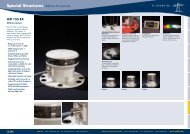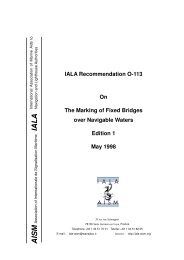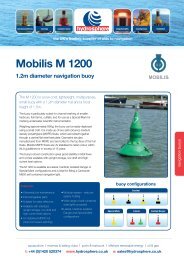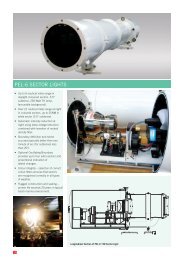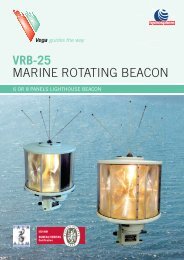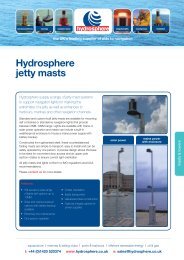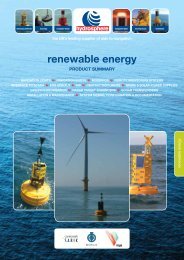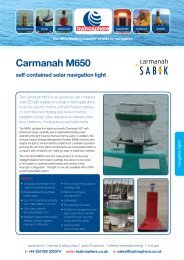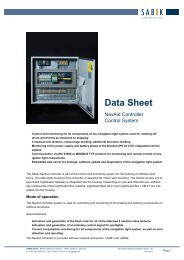Hydrosphere UK Ltd Complete Products & Services Catalogue
Hydrosphere UK Ltd Complete Products & Services Catalogue
Hydrosphere UK Ltd Complete Products & Services Catalogue
You also want an ePaper? Increase the reach of your titles
YUMPU automatically turns print PDFs into web optimized ePapers that Google loves.
OSCILLATING BOUNDARY APPLICATIONS<br />
Mark a A Turning Track (Tory Channel, NZ)<br />
Cook Strait, between the two islands of New Zealand, is<br />
a very rough stretch of water with strong tidal rips, and is<br />
exposed to strong winds. A regular inter-island rail ferry must<br />
initiate a turn from inside the sound to exit through an unlit<br />
narrow passage, while remaining clear of rocks on each side<br />
of the channel. The PEL Sector Light fi tted with oscillating<br />
boundary provides the pilot of the relatively cumbersome<br />
ferry with a progression of distinct sectors to turn through as<br />
he emerges into the strait.<br />
Multi-Leg Entrance into a Harbour (Lyttleton, NZ)<br />
A 10° PEL Sector Light with oscillating boundary provides the<br />
main lead into this harbour. The oscillating boundary system<br />
makes it easier to maintain the correct track, by giving early<br />
warning of lateral deviation. Once within the inner harbour,<br />
a second PEL Light (of 5 degrees total subtense for greater<br />
intensity) is used to mark a narrow dredged channel. This<br />
simple system of two PEL Sector Lights replaced a more<br />
complicated and costly arrangement of shore-based lights<br />
and fl oating buoys.<br />
Marlborough Sounds<br />
Lyttleton Harbour<br />
Cook Strait<br />
One PEL-3-5D Sector Light<br />
One PEL-3-5D Sector Light<br />
One PEL-3-10D Sector Light<br />
Diffi cult Turn Onto Narrow Track (all 7 sectors used)<br />
Adverse wind and current makes turning large vessels<br />
diffi cult. Speed is required to maintain steerage, and extra<br />
information is needed to execute the turn safely. The use of all<br />
seven possible sectors in a PEL Sector Light gives the mariner<br />
the best information. Flashing red on fi rst encounter initiates<br />
the start of the turn. The transition to steady red occurs halfway<br />
through the turn, the alternating red/white sector is next<br />
traversed, and fi nal alignment is gradually achieved within the<br />
narrow white sector.<br />
Turning Circle (Mermaid Sound)<br />
Two PEL Sector Lights are located at a petroleum terminal,<br />
and the lights are enclosed in fl ameproof enclosures. The<br />
restricted area of the turning basin is defi ned by these sector<br />
lights. Each white and alternating sector is 100 metres wide<br />
at the centre of the basin. The oscillating boundary gives a<br />
clear indication of progress around the turning track in either<br />
direction, assisting the tanker to arrive at the jetty in the<br />
correct position. This system is simpler, more reliable and less<br />
costly to maintain than a buoyage system.<br />
Fl G<br />
G<br />
Ship's Signal<br />
Position Displayed<br />
A<br />
B<br />
C<br />
D<br />
E<br />
Jetty<br />
Star Rock<br />
Turning Basin<br />
C<br />
E<br />
D<br />
B<br />
A<br />
Alt G/ W<br />
W<br />
Alt R/W<br />
R<br />
Fl R<br />
Cooling Water<br />
Intake<br />
One PEL-6-20 Sector Light<br />
Two PEL Lights with<br />
Oscillating Boundary<br />
19



